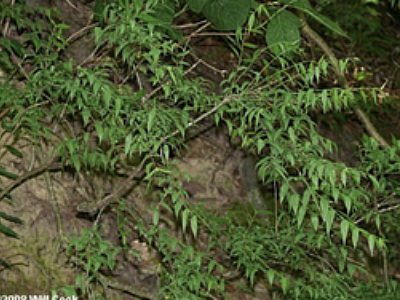Grant funds have always played a major role in the projects we accomplish at Landis. From concerts to renovations, trail work to interpretive signage, awarded grants have allowed us to keep our collections and grounds thriving. In late 2019, we finalized the details of a grant award from the Schoharie County Soil and Water Conservation District. These funds enable us to revitalize our rare and unique Buckleya collection and to remove invasive plant species from our wildflower and pollinator meadows.

Buckleya distichophylla, commonly called “piratebush,” is threatened or endangered in its native range, which includes Tennessee, Virginia, and North Carolina. This plant is thriving at Landis, and botanists consider our collection as one of the best preserved. Buyckleya is unusual in that it is a hemiparasitic plant, meaning that it attaches to the root systems of other (host) plants with structures called haustoria and draws nutrients through them. Host plants for the piratebush at Landis include eastern hemlock, pine, and larch trees.
The Soil and Water grant allowed us to remove invasive plants that have been steadily encroaching our Buckleya Collection. These include Lonicera tatarica (Tatarian honeysuckle), and Rhamnus cathartica (common buckthorn), both listed on the NYS invasive species list. L. tatarica is a perennial shrub that forms a very dense population which outcompetes and suppresses native plants. R. cathartica is a small deciduous tree forming thick hedges with long branches that crowd and shade out native shrub and herbaceous plants. The restoration involved Landis’ grounds man Russell Glass removing those invasive specimens one by one, carefully working with hand tools in order to avoid damaging the Buckleya. The funding also made it possible to purchase a protective fence and interpretive signs for visitors.
Another portion of the funding was used to remove and contain invasive species in our wildlife and pollinator meadows. We used a brush hog for this, working late in the season to avoid any animals or ground nesting birds. The invasive species removed included L. tatarica, R. cathartica, and Robinia pseudoacacia (black locust). R. pseudoacacia is native to the southeastern U.S., but is considered an invasive outside of that range. Once introduced, black locust spreads easily, shading out other sun loving plants.
In 2020, Landis will continue to solicit funds to keep our grounds and collections healthy and habitats thriving. Through grant awards, memberships, and the dedication of our trustees, volunteers, and staff, we will uphold our dedication to provide a native plant diversity for all to enjoy.
